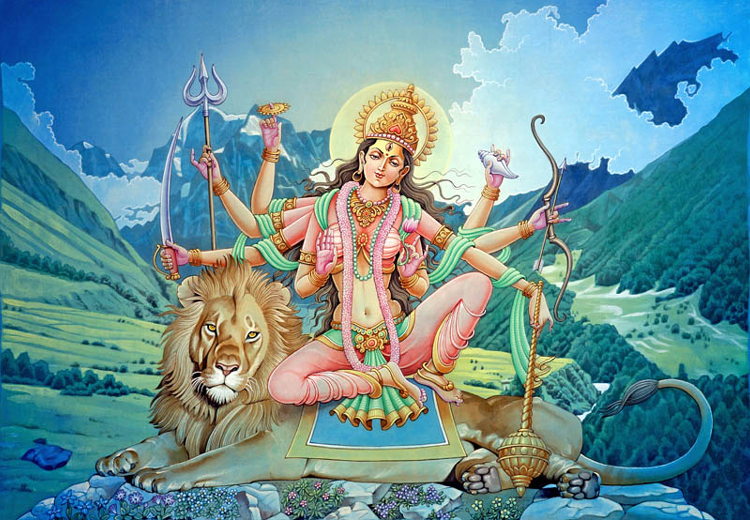The third day of Navratri is dedicated to Goddess Chandraghanta, a fierce yet benevolent form of Goddess Durga. She symbolizes the power of destruction of evil and the importance of maintaining peace and tranquility. The name “Chandraghanta” translates to “the one who has a moon (chandra) on her forehead,” which signifies her serene nature and profound inner strength.
Goddess Chandraghanta is known for her courage and valor, and worshipping her on this day is believed to instill confidence, fearlessness, and a sense of protection among devotees. Her blessings are sought to overcome obstacles, dispel negativity, and cultivate a strong sense of righteousness.
Who is Goddess Chandraghanta?
Goddess Chandraghanta is depicted as a beautiful woman with a bell-shaped moon adorning her forehead. She rides a lion, symbolizing power and courage, and is often shown holding a variety of weapons in her multiple hands, representing her readiness to protect her devotees from any harm.
Her form combines both ferocity and grace, showcasing the duality of her nature. While she possesses the strength to vanquish evil, she also embodies compassion and empathy toward her devotees. This balance makes her an important deity to worship on the third day of Navratri.
The Symbolism of Goddess Chandraghanta
The iconography of Goddess Chandraghanta carries profound symbolism:
- Moon on the Forehead: The moon represents tranquility, beauty, and serenity. It signifies the importance of maintaining peace and calmness amidst chaos and challenges.
- Lion as Her Vahana (Vehicle): The lion symbolizes strength, courage, and royal authority. It represents the fierce aspect of the goddess that fights against evil and injustice.
- Weapons in Her Hands: The various weapons—such as a sword, trident, and bow—symbolize her readiness to combat negativity and protect her devotees. They remind worshippers that the power to overcome obstacles lies within them.
The Story of Goddess Chandraghanta
The legend of Goddess Chandraghanta is rooted in the epic narratives of Hindu mythology. According to the stories, when the gods faced numerous challenges from powerful demons, they prayed to Goddess Durga to help them restore cosmic order and eliminate evil forces.
In response to their prayers, Goddess Durga manifested as Chandraghanta, radiating immense power and strength. She engaged in fierce battles with the demons, showcasing her valor and fierce determination to protect the dharma (righteousness).
Her role in defeating the forces of evil highlights the significance of inner strength and moral courage. Goddess Chandraghanta’s story inspires devotees to remain steadfast in their convictions and to fight against injustices in their lives.
Rituals and Traditions on the Third Day of Navratri
On the third day of Navratri, devotees engage in various rituals and traditions to honor Goddess Chandraghanta, seeking her blessings for courage, strength, and protection.
1. Fasting and Offerings
Many devotees observe fasts on the third day, dedicating themselves to spiritual practices and self-discipline. The fast can vary from complete abstinence from food to consuming light meals such as fruits and dairy.
Devotees prepare special offerings of sweets and fruits for the goddess, such as kheer (rice pudding), laddus, and fresh fruits. These offerings symbolize gratitude and devotion, inviting the goddess’s blessings into their homes.
2. Chanting and Prayers
Devotees recite mantras and prayers dedicated to Goddess Chandraghanta to invoke her energy and seek her guidance. The most common mantra for her worship is:
“Om Devi Chandraghantayai Namah”
Chanting this mantra is believed to bring peace, courage, and strength to overcome obstacles.
3. Decorating the Altar
Devotees decorate their altars with flowers, particularly red and yellow, which symbolize prosperity and auspiciousness. They often light lamps and candles to illuminate the space, representing the dispelling of darkness and negativity.
The Spiritual Significance of Worshipping Chandraghanta
The third day of Navratri, dedicated to Goddess Chandraghanta, holds deep spiritual significance. Her worship serves as a reminder of the power of inner strength, courage, and the importance of fighting against evil.
1. Inner Strength and Fearlessness
Goddess Chandraghanta embodies the qualities of fearlessness and strength, inspiring devotees to confront their challenges head-on. Her blessings instill confidence, allowing individuals to tackle obstacles and fears in their lives.
2. Righteousness and Justice
Worshipping Chandraghanta reinforces the importance of standing up for righteousness and justice. Devotees are encouraged to take a stand against negativity and injustice, embodying the strength and determination of the goddess.
3. Balancing Power and Compassion
Goddess Chandraghanta teaches that true strength lies in the ability to balance power with compassion. While she is fierce in battle against evil, she also possesses a nurturing and caring nature, reminding devotees to approach situations with empathy and kindness.
Celebrations Across India
The third day of Navratri is celebrated with enthusiasm and devotion across various regions of India, each adding unique cultural elements to the festivities.
- In Gujarat, the vibrant Garba and Dandiya nights continue, with dancers adorned in traditional attire celebrating the goddess’s energy through dance and music.
- In Maharashtra, devotees visit temples dedicated to Goddess Durga, where special prayers and rituals are performed in honor of Chandraghanta.
- In Punjab, the day is marked by collective prayers and community gatherings, where people come together to celebrate the goddess’s power and blessings.
Conclusion: Embracing Strength and Courage on the Third Day
The third day of Navratri, dedicated to Goddess Chandraghanta, is a celebration of courage, strength, and the triumph of good over evil. As devotees worship her, they are inspired to cultivate these qualities within themselves and to face life’s challenges with resilience and determination.
Goddess Chandraghanta serves as a powerful reminder that true strength comes from within, and with her blessings, devotees are empowered to stand firm in their beliefs, dispel negativity, and embrace their inner warrior. As we honor her on this auspicious day, may we all find the courage to fight for righteousness and maintain peace in our lives.

